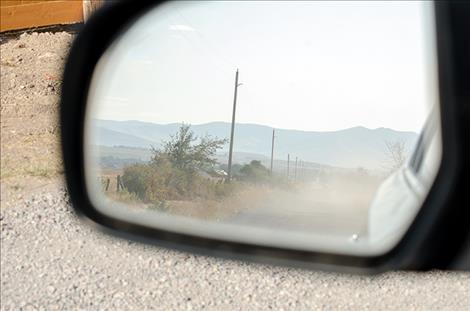Decreased rainfall cause of ‘drought disaster’ declaration for Flathead Reservation
Hey savvy news reader! Thanks for choosing local.
You are now reading
3 of 3 free articles.
A lack of rain caused more problems besides wildfires for Lake County and the Flathead Indian Reservation this summer, and the season isn’t over.
According to the United States Drought Monitor, “below average” rates of rainfall created the drought. The monitor is used as a tool by the government to trigger disaster areas and make it easier for people to apply for disaster relief programs.
Drought monitoring scientists put together a map showing the driest places in the country. A section of northwest Montana is in the orange rating for “severe drought” conditions. “Dry conditions were “particularly notable in Montana where wildfires are prevalent,” documents state.
Eastern Montana and parts of North Dakota are experiencing “exceptional drought” conditions. Basically, a strip along the northwestern and central part of the country shows abnormally dry conditions this August.
Montana was so dry that Governor Steve Bullock issued an executive order to declare the reservation in a drought disaster along with five other reservations and 31 counties due to the absence of significant precipitation and sustained high temperatures, causing a loss of moisture in soils and vegetation.
The governor designated the reservation as a disaster but didn’t designate the county as a disaster area, yet. According to Ed Daugherty, Farm Service Agency executive director for Lake and Sanders counties, federal programs won’t go into effect until the county is designated a disaster.
Daugherty said dry conditions are in the forecast for the drought to intensify, which will trigger federal programs for the county. According to the Climate Prediction Center’s outlook for the next ten days, the Midwest and Northwest will remain dry.
Lake County commissioners are taking action due to the dry conditions. They decided to keep the county under a stage-two fire restriction order on Friday until conditions change, affecting where people can have campfires, log and smoke cigarettes.
Commissioner Bill Barron said dry, hot dust is a problem for people in the county. The dirt dries as the moisture content lowers, creating a fine powder that fills the air. Commissioner Dave Stipe said cars driving on dirt roads at high speeds push dust into the air, which – adding to the smoke – makes the air more polluted.
In the past, commissioners tried to set a countywide speed restriction to keep the dust down but it was difficult to enforce. Now, they ask that people try to maintain slower speeds on dirt roads.
Lake County Road Supervisor Jay Garrick said people can get a permit from the county to have abatement products applied to unpaved roads to reduce dust. Another option includes having the road chip sealed. He said homeowners in some areas have pooled together to pay for fifty percent of the cost of the process of chip sealing, which is added to their taxes. The county covers the remaining 50 percent of the cost.
The increase in fires this season is also a drain on law enforcement funding. Stipe said officers are sent to the fires like the one at Blue Bay to direct traffic and they end up working overtime.
“This is an unusual year,” Stipe said. “Last year we had rain in the middle of the year, but we are at the end of the season, so we will see what happens.”
Barron said the county isn’t expected to get any funding for disaster relief as of Monday, although the summer isn’t over. He said something unforeseen could be impacted by the drought, causing the county to apply for funding.
Lake County Extension Officer Jack Stivers said the drought affects everyone in some way, but dry land farmers are really affected. Fields irrigated by water stored in reservoirs are not seeing as big of an impact as long as they continue to put water on their fields.
Dry land farmers are seeing an impact to crops like wheat, barley, and hay forage. These are crops that depend on the rain and not irrigation.
Rick Van Voast is a farmer in the Polson area who depends on the rain for his dry land farming operation.
“My dad had a saying: ‘If you get rain in the first week of June, it’ll rain every week in June.’ But we didn’t get that this year,” he said.
The rain apparently came down too early.
“It was one of the wettest springs I can remember,” he said. “I was getting stuck in the mud more than usual.”
The wet spring made it difficult for him to plant his crops in April, so he waited until May, and got them in just in time. “It would have been a lot worse if we had waited.”
His winter wheat crop ended up doing okay. He got 58 bushels and usually averages 60. The spring wheat crop didn’t do so well.
“We had half the crop that we usually get with 28 bushels, but east of the mountains they got nothing,” he said.
He said the damage isn’t really noticeable when people drive by and look out across thick wheat fields. “You have to look at the heads on the wheat,” he said. His spring wheat plants produced four heads this year instead of ten.
In farming, a lower yield isn’t always completely bad.
“With fewer bushels (around the country), the price for spring wheat is up, so it balances out” he said. “And the protein was high.”
Besides paying for insurance, he said there wasn’t much he could do about nature. His dad had another saying that sticks with him: “We’ll make up for it next year.”
At this time, the Livestock Forage Program is not available in Lake and Sanders Counties. More information on programs can be found at www.drought.mt.gov or by calling the Lake County Farm Service Agency at 406-676-2811.

















